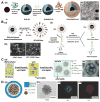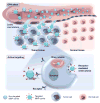Magnetic Nanoparticle Facilitated Drug Delivery for Cancer Therapy with Targeted and Image-Guided Approaches
- PMID: 27790080
- PMCID: PMC5077153
- DOI: 10.1002/adfm.201504185
Magnetic Nanoparticle Facilitated Drug Delivery for Cancer Therapy with Targeted and Image-Guided Approaches
Abstract
With rapid advances in nanomedicine, magnetic nanoparticles (MNPs) have emerged as a promising theranostic tool in biomedical applications, including diagnostic imaging, drug delivery and novel therapeutics. Significant preclinical and clinical research has explored their functionalization, targeted delivery, controllable drug release and image-guided capabilities. To further develop MNPs for theranostic applications and clinical translation in the future, we attempt to provide an overview of the recent advances in the development and application of MNPs for drug delivery, specifically focusing on the topics concerning the importance of biomarker targeting for personalized therapy and the unique magnetic and contrast-enhancing properties of theranostic MNPs that enable image-guided delivery. The common strategies and considerations to produce theranostic MNPs and incorporate payload drugs into MNP carriers are described. The notable examples are presented to demonstrate the advantages of MNPs in specific targeting and delivering under image guidance. Furthermore, current understanding of delivery mechanisms and challenges to achieve efficient therapeutic efficacy or diagnostic capability using MNP-based nanomedicine are discussed.
Figures









References
Grants and funding
LinkOut - more resources
Full Text Sources
Other Literature Sources
